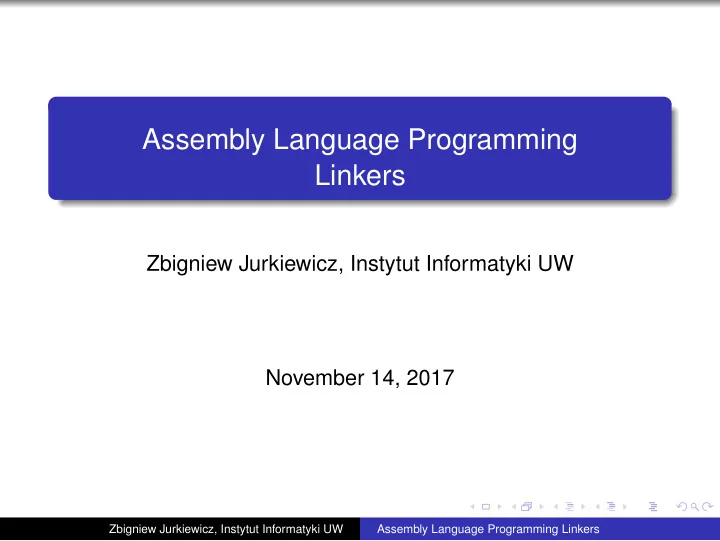

Assembly Language Programming Linkers Zbigniew Jurkiewicz, Instytut Informatyki UW November 14, 2017 Zbigniew Jurkiewicz, Instytut Informatyki UW Assembly Language Programming Linkers
Placement problem (relocation) Because there can be more than one program in the memory, during compilation it is impossible to forecast their real addresses. Labor division: linker: allocation of memory = preparation of relative addresses in program loader: final relocation Zbigniew Jurkiewicz, Instytut Informatyki UW Assembly Language Programming Linkers
Architectural solutions The hardware relocation (relocation registers) and virtual memory have simplified the job of a linker. Each program get the whole (virtual) address space. But there appeared a new element: code sharing , which forced the physical division of programs into code and data sections. Zbigniew Jurkiewicz, Instytut Informatyki UW Assembly Language Programming Linkers
Linker tasks Consolidate binary modules Combine relocatable binary modules into a single executable file, which will be loaded by the loader. Solve external references They must be solved during consolidation process. External reference: reference to a symbol in another module. Relocate symbols Connect symbolic names with relative addresses described in the contexts of modules (.o files) with final absolute addresses in executable code. Example: getline in iosys module ↔ address 612 bytes from the beginning of the executable code. Perform code fixups : update all references to this symbols to make them correspond to their new addresses. Zbigniew Jurkiewicz, Instytut Informatyki UW Assembly Language Programming Linkers
Relocation Assembler generated addresses are not relocated. For example assume that in mov eax,[a] mov [b],eax a has local address (offset) 0x1234 , and b is imported. Code after assembly A1 34 12 00 00 mov eax,[a] A3 00 00 00 00 mov [b],eax During linkage process the linker decides, that the section containing a is to be relocated 0x10000 bytes, and b has address 0x9A12 A1 34 12 01 00 mov eax,[a] A3 12 9A 00 00 mov [b],eax Zbigniew Jurkiewicz, Instytut Informatyki UW Assembly Language Programming Linkers
Relocation Similar modifications are necessary for data section, if it contains pointers, e.g. in the table of procedure addresses. RISC generate more problems, because an address is often build by two or three consequent instructions. Zbigniew Jurkiewicz, Instytut Informatyki UW Assembly Language Programming Linkers
Formats of binary files In Unix binary files (and other files too) start with 32-bit long magic number , which determines the type of a file. Traditional, but now rarely used, format of binary file in Unix is a.out . Its magic number is 0x407 . It has been mostly replaced by the ELF format. Zbigniew Jurkiewicz, Instytut Informatyki UW Assembly Language Programming Linkers
Format a.out Header a.out Section text Section data Other sections Optional relocation information Zbigniew Jurkiewicz, Instytut Informatyki UW Assembly Language Programming Linkers
Format ELF ELF header Program header table (dla loadera) .text section .data section .bss section .symtab .rel.text .rel.data .debug Section header table (relocation info for linker) Zbigniew Jurkiewicz, Instytut Informatyki UW Assembly Language Programming Linkers
ELF format ( Executable and Linking Format ) Now basic format in Unix with magic number 0x177 = ’ELF’ It is used for storing executable programs, as well as object modules and libraries (and also memory dumps). So has different type: relocatable, executable, shared , core image . So it is possible to place there informations necessary for liker and for loader too. File starts with general header, then there is program segment table (description of segments for loader). Zbigniew Jurkiewicz, Instytut Informatyki UW Assembly Language Programming Linkers
ELF format This is followed by proper file contents, that is sections: code .text initialized data .data non-initialized data .bss .symtab : symbol table .rel.text : relocation info for .text .rel.data : relocation info for .data .debug : debugger info (if gcc -g was used) The file concludes with a section header table, which describes all sections for linker use. Zbigniew Jurkiewicz, Instytut Informatyki UW Assembly Language Programming Linkers
Libraries Libraries divide into static and shared (aka. dynamic). With static libraries you have to relink program after each modification of program or libraries . Zbigniew Jurkiewicz, Instytut Informatyki UW Assembly Language Programming Linkers
Shared libraries Shared libraries divide into loaded statically or dynamically. for libraries loaded statically the addresses (placement) are decided during program load (at load-time, if you prefer); libraries loaded dynamically can be loaded at run-time as needed, at the first call to their procedures (such procedures are sometimes called autoloaded ). Shared libraries should contain Position Independent Code (PIC), to make it possible to load them into any area of memory (e.g. gcc compiler has an option for that). Zbigniew Jurkiewicz, Instytut Informatyki UW Assembly Language Programming Linkers
Dynamic linkage: methods Implicit linking With a program we associate a linkage segment , describing external procedures called from dynamic libraries as pairs [ name , address (initially equal 0, i.e. incorrect)]. The code contains indirect calls through this address, except for the first time, bacause initially it is a trap to dynamic linker, resulting in incremental linking of necessary library and filling the address field. Explicit linking Program in its prologue specifies all used shared libraries and links with them. Zbigniew Jurkiewicz, Instytut Informatyki UW Assembly Language Programming Linkers
Creating a dynamic library To build a dynamic library, we use assembler as usual nasm -f elf64 pakiet.asm However when declaring the exported symbols we should specify their ich type: function or data , for example global random:function,seed:data Linkage will be different ld -shared -o libpakiet.so pakiet.o Zbigniew Jurkiewicz, Instytut Informatyki UW Assembly Language Programming Linkers
Creating a dynamic library The library built that way can be used similarly to system libraries ld -L . -dynamic-linker /lib/ld-linux.so.2 \ -o program program.o -l pakiet Before running a program we must appropriately set the environment variable, for example export LD_LIBRARY_PATH=. Utility ldd called with binary program name will tell us, which shared libraries are used, and which have not been found. Utility nm gives all external symbols of any binary module. Zbigniew Jurkiewicz, Instytut Informatyki UW Assembly Language Programming Linkers
Recommend
More recommend